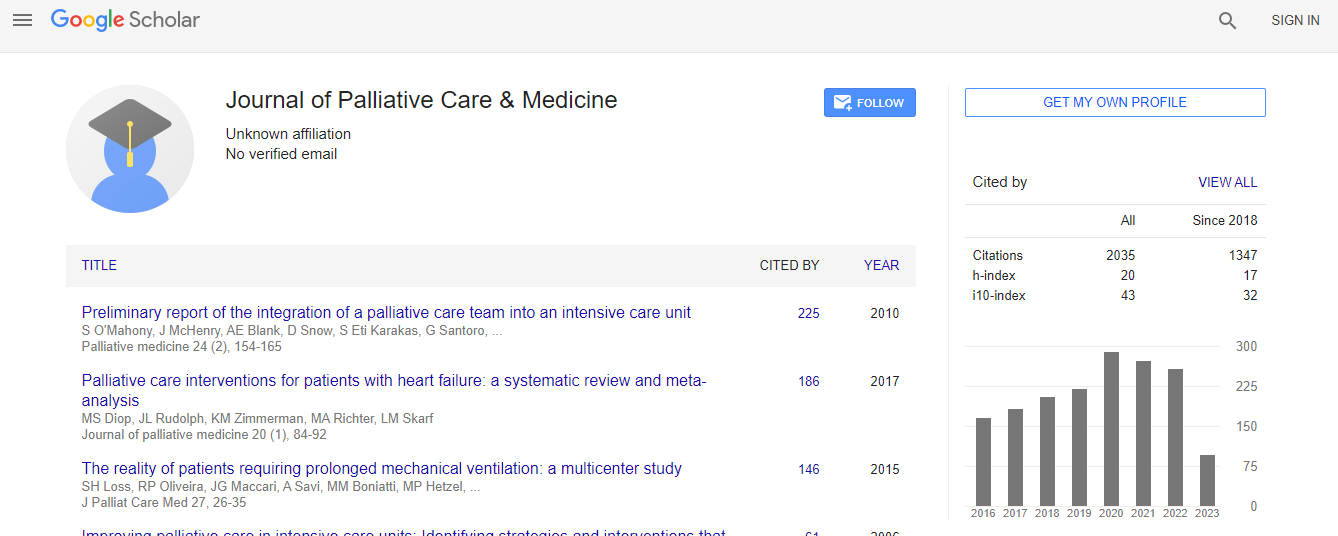Our Group organises 3000+ Global Conferenceseries Events every year across USA, Europe & Asia with support from 1000 more scientific Societies and Publishes 700+ Open Access Journals which contains over 50000 eminent personalities, reputed scientists as editorial board members.
Open Access Journals gaining more Readers and Citations
700 Journals and 15,000,000 Readers Each Journal is getting 25,000+ Readers
Google Scholar citation report
Citations : 1689
Journal of Palliative Care & Medicine received 1689 citations as per Google Scholar report
Journal of Palliative Care & Medicine peer review process verified at publons
Indexed In
- Index Copernicus
- Google Scholar
- Open J Gate
- Genamics JournalSeek
- China National Knowledge Infrastructure (CNKI)
- Electronic Journals Library
- RefSeek
- Hamdard University
- EBSCO A-Z
- OCLC- WorldCat
- Virtual Library of Biology (vifabio)
- Publons
- Geneva Foundation for Medical Education and Research
- Euro Pub
- ICMJE
Useful Links
Recommended Journals
Related Subjects
Share This Page
EMERGENCY MEDICAL SYSTEM AND NURSING HOME PATIENTS: IS THERE A WAY TO BETTER USE EXISTING RESOURCES TO IMPROVE THE QUALITY OF CARE?
2nd Global Congress on Hospice & Palliative Care
Fabrice Dami
Lausanne University Hospital, Switzerland
Posters & Accepted Abstracts: J Palliat Care Med
Abstract
Background: Our population is aging and there are a growing number of Nursing Home (NH) residents who benefit from ambulance transport to the Emergency Department (ED), which are not known to be ├ó┬?┬?senior friendly├ó┬?┬? and are often on surge capacity. Simultaneously, we face a reduced availability of General Practitioners (GP) to visit these patients prior their transport to the ED. Hypothesis: Many NH patients are transported by ambulance to the ED without having benefitted from a medical evaluation on site. Palliative and end of life care could sometimes be provided on site rather than having the patient transported. Setting: The State of Vaud (Switzerland) dispatch centre sends ambulances and, when a life-threatening situation is suspected, a Pre-hospital Emergency Physician (PEP) too. Results: We previously published a case series where PEPs have been able to provide palliative and end of life care on site, according to the patient and relative├ó┬?┬?s will, and we with the support of the NH. Discussion: EMS systems that dispose of PEPs should use this resource not only for life-threatening emergencies but also to provide palliative and end of life care, when all parties (patient, relatives, NH) agree with this strategy, therefore avoiding unnecessary transport to crowded ED.Biography
Email: Fabrice.Dami@chuv.ch

 Spanish
Spanish  Chinese
Chinese  Russian
Russian  German
German  French
French  Japanese
Japanese  Portuguese
Portuguese  Hindi
Hindi 
